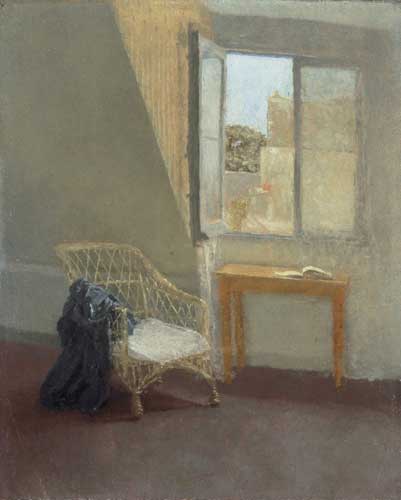Great Works: A Corner Of The Artist's Room In Paris (With Open Window)(1907-1909), Gwen John
National Museums & Galleries of Wales

Gwen John's A Corner of the Artist's Room in Paris (with Open Window) of 1907-9 shows a wicker chair set next to a small wooden table. It was painted in her attic room of an 18th-century house in the Rue du Cherche Midi. On the table is an open book and on the chair a discarded dress of luminous blue. Light floods in through the open window, and our gaze is drawn outside to soft flowery blues and greens, and beyond to a pale blue, probably, morning sky.
It is spring or early summer. All is fresh, clean and radiant. It is as close to a love poem as a painting can get. In 1904, the Welsh painter, sister of the flamboyant Augustus, came to Paris where she became a model for Auguste Rodin, with whom she fell obsessively in love. Setting her up in a room for which he paid the rent, she wrote to him: "My room is so delicious after a whole day outside, it seems to me that I am not myself except in my room."
For a time, her affair with Rodin obliterated any interest in painting, but when he began to ignore her, she started painting the corner of her room, a placid scene, that belies her maelstrom of conflicted emotions. "It /is /me," John told a friend. But it is also a representation of how the much the older Rodin counselled her, as he withdrew from their liaison, to be; a picture of: "contentment, peace, a life lived sweetly and quietly. No mess, no trouble, no agonizing".
The room is striking for both her absence and his. Everything is spick and span – "fraiche et jolie" – as if permanently awaiting Rodin's presence. The open window, the book, and the empty dress all denote her vulnerability, her longing and her availability. She has created perfection in this her little bit of Paris, but still he does not come. The painting is virtually a self-portrait. Beside herself with despair, she stayed in all day awaiting his visits, which more frequently did not happen. And while waiting she painted, to avoid what feminist scholars have termed "the madwoman in the attic" syndrome; a state of rejected despair that can be traced through the work of great 19th-century writers such as Emily Dickinson.
Yet there is also a contradiction at the painting's heart. For despite her "scorching, exalting" passion for Rodin, John consciously avoided the "ultimate impediment" of domesticity, writing to a friend in 1910: "I think to do beautiful pictures we ought to be free from family conventions as ties ... I think the family has had its day." She was an ambitious painter who chose her art over domesticity and motherhood.
The calculated geometry of her compositions, the pale tones and subtle colouring all speak of formal concerns. She had a talent for obsession, but the repetition in her work (there is more than one version of this painting) speaks as much of a modernist engagement with the process of picture making, similar to that of Monet's Haystacks, as it does her state of mind. Her room is a potential love nest, and a site of desire, but it is also, ironically, what Virginia Woolf called "a room of one's own", a tranquil space essential to the life and work of an independent woman artist.
Feminists have tended to claim John as their own. Yet, she was not particularly discriminated against, had, since childhood, enjoyed a good deal of freedom, and was the beneficiary of a generous patron. Nor did she align herself with nascent feminist ideas, but rather with the Catholic revival. Both her interiors and her female subjects are still and subdued, like convent rooms or holy sisters; "recueilli" as she liked to describe herself. Yet this was also the same woman who had walked unchaperoned from Bordeaux to Toulouse, lived independently, and posed naked for Rodin, making love with him on his studio floor.
For all their femininity John's paintings have a determined strength about them. She wrote: "I don't live when I spend time without thought". The canvases she painted of her Parisian room show that process, pathos, and self-examination are all inextricably joined. The paintings' power is in their conjunction.
About the artist
Born in Pembrokeshire, in 1876, Gwen John had a sister and two brothers, one of which, Augustus, was to become a flamboyant and successful painter. In 1895 she went to the Slade, then to Paris. There she modelled for, and fell in love with Rodin who was a major influence on her work. Setting exacting standards she painted quiet, intense paintings mostly of women in rooms. Today she is considered a more significant and original painter than her brother.
Join our commenting forum
Join thought-provoking conversations, follow other Independent readers and see their replies
Comments